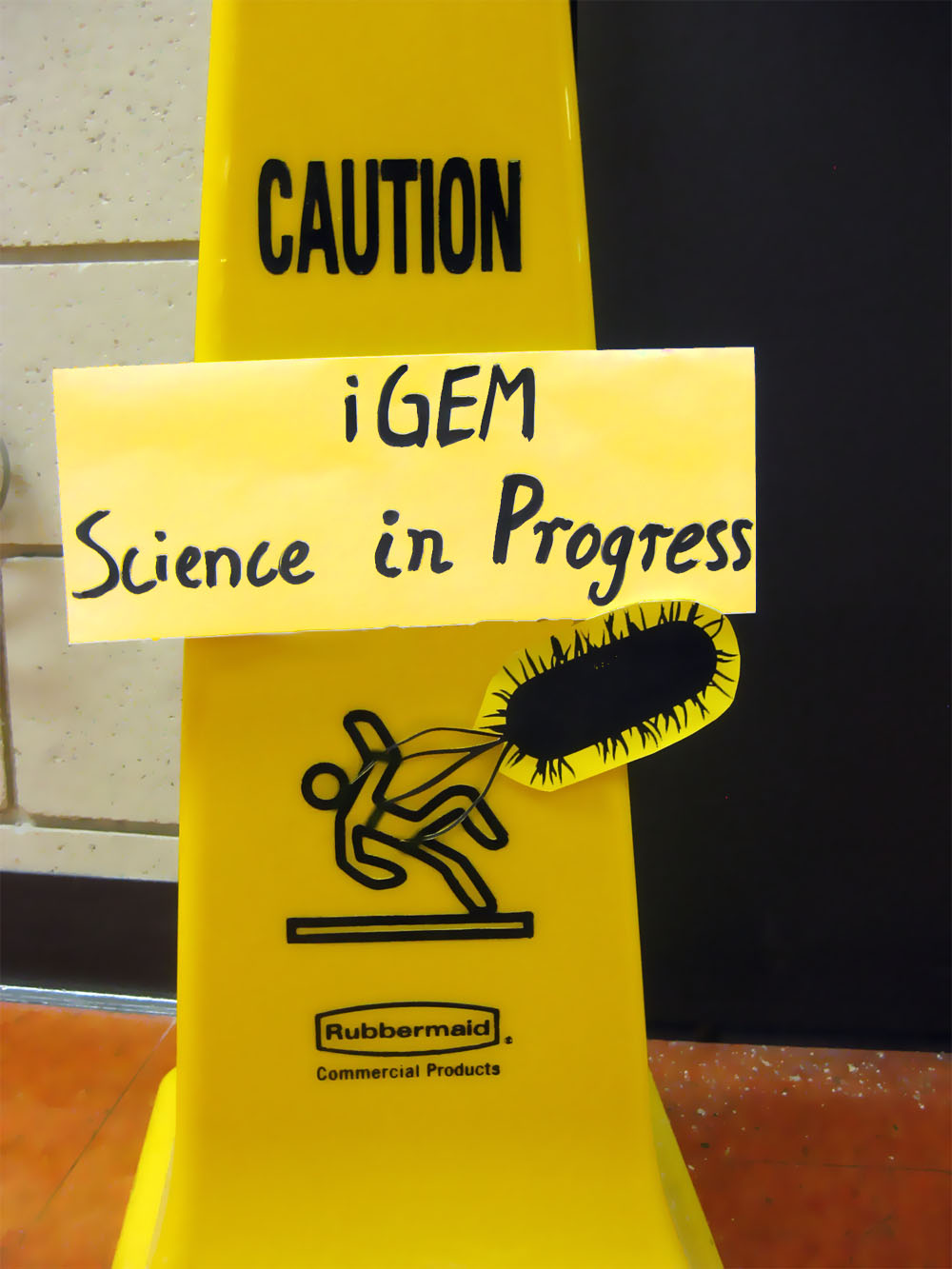Team:Northwestern/Safety
From 2011.igem.org
(Difference between revisions)
Helenmelon (Talk | contribs) |
Helenmelon (Talk | contribs) |
||
| Line 10: | Line 10: | ||
[[Image:Igem_wetfloor_sign_complete.jpg|300px|right]] | [[Image:Igem_wetfloor_sign_complete.jpg|300px|right]] | ||
| - | #'''Would the materials used in your project and/or your final product | + | #'''Would the materials used in your project and/or your final product pose:''' |
| - | pose:''' | + | |
#*'''Risks to the safety and health of team members or others in the lab?''' | #*'''Risks to the safety and health of team members or others in the lab?''' | ||
#:Our project deals with Pseudomonas aeruginosa, which is a fairly common organism but can colonize in immuncompromised patients. Despite its low pathogenicity in healthy adults, our team tried our best to minimize any possible health issues that could arise. In order to extract necessary genes from the organism, we worked with the genomic DNA, obtained through ATCC, instead of the actual organism itself, which would have raised much greater safety concerns. We are not extracting genes for virulent components of P. aeruginosa and are only using the quorem sensing and interaction mechanism. As a result, our team only worked with the non-infectious E. coli host organism in a Biosafety Level 1 environment. | #:Our project deals with Pseudomonas aeruginosa, which is a fairly common organism but can colonize in immuncompromised patients. Despite its low pathogenicity in healthy adults, our team tried our best to minimize any possible health issues that could arise. In order to extract necessary genes from the organism, we worked with the genomic DNA, obtained through ATCC, instead of the actual organism itself, which would have raised much greater safety concerns. We are not extracting genes for virulent components of P. aeruginosa and are only using the quorem sensing and interaction mechanism. As a result, our team only worked with the non-infectious E. coli host organism in a Biosafety Level 1 environment. | ||
Revision as of 19:52, 26 August 2011
PROJECT

RESULTS

CONSIDERATIONS

ABOUT US

NOTEBOOK

ATTRIBUTIONS

Safety Proposal
- Would the materials used in your project and/or your final product pose:
- Risks to the safety and health of team members or others in the lab?
- Our project deals with Pseudomonas aeruginosa, which is a fairly common organism but can colonize in immuncompromised patients. Despite its low pathogenicity in healthy adults, our team tried our best to minimize any possible health issues that could arise. In order to extract necessary genes from the organism, we worked with the genomic DNA, obtained through ATCC, instead of the actual organism itself, which would have raised much greater safety concerns. We are not extracting genes for virulent components of P. aeruginosa and are only using the quorem sensing and interaction mechanism. As a result, our team only worked with the non-infectious E. coli host organism in a Biosafety Level 1 environment.
- Risks to the safety and health of the general public if released by
design or accident?
- Since the goal of our project is to detect P. aeruginosa in patients, we hope that our design can eventually be utilized in a hospital environment. However, our design would not require the exposure of our engineered organism to an actual patient. Rather, a sample would be obtained from a patient and our sensor would be used in a separate, contained environment. Because of this, our engineered organism exhibits low public safety risk.
- Risks to environmental quality if released by design or accident?
- Our product will not be exposed to the environment because it is designed to be used in a controlled environment. In the event of a spill, our engineered organism does not produce toxins and should exhibit low environmental safety risk.
- Risks to security through malicious misuse by individuals, groups, or states?
- Do any of the new BioBrick parts (or devices) that you made this year raise any safety issues?
- No, our new BioBrick parts do not raise safety issues. Our parts do not produce toxic proteins nor anaphylatoxins, do not enhance cell chasis environments, and devices combined from several parts so far have not exhibited abnormal or unexpected behavior.
- No, our new BioBrick parts do not raise safety issues. Our parts do not produce toxic proteins nor anaphylatoxins, do not enhance cell chasis environments, and devices combined from several parts so far have not exhibited abnormal or unexpected behavior.
- Is there a local biosafety group, committee, or review board at your institution? If yes, what does your local biosafety group think about your project?
- The Northwestern University Office for Research Safety (ORS) and the Northwestern University Institutional Biosafety Committee (IBC) both work to ensure ethical research practices. Our project is subject to standard laboratory regulations for general safety and recombinant DNA work. Had we sought review outside of our adviser's IBC approval, we would need to address researcher, public, and environmental concerns listed above in greater detail.
- The Northwestern University Office for Research Safety (ORS) and the Northwestern University Institutional Biosafety Committee (IBC) both work to ensure ethical research practices. Our project is subject to standard laboratory regulations for general safety and recombinant DNA work. Had we sought review outside of our adviser's IBC approval, we would need to address researcher, public, and environmental concerns listed above in greater detail.
- Do you have any other ideas how to deal with safety issues that could be useful for future iGEM competitions? How could parts, devices and systems be made even safer through biosafety engineering?
- iGEM acknowledges that the current datasheets on registered biobricks contain very little information on safety. Currently, information is given only given regarding genetic and performance reliability of parts. One suggestion would be to increase the amount of information provided. For example, in order for a team to submit or update information about a certain part, they should be required to fill out a section specifically addressing safety recommendations for future groups who are considering using that part for their project.
- iGEM encourages the construction of standard and interchangeable for the construction of integrated biological systems. While it would be highly efficient to engineer all the possible genetic sequences involved in a specific system, it would pose a safety risk if the system is virulent. Should the strain be exposed to an outside prokaryote, all the genetic material required to become virulent will become available to the organism. A suggestion to prevent such an occurrence is to use multiple plasmids consisting of different parts which are all functionally dependent upon each other. By implementing a standardized control hierarchy, strains are rendered useless in the absence of their counterparts. Additionally, kill switches on each individual strain can prevent the proliferation of contaminated strains. Moreover, if kill switches deactivate a part of the hierarchical system, the functionality of the whole system would come crashing down, preventing further growth of uncontrolled and contaminated organisms.
- iGEM acknowledges that the current datasheets on registered biobricks contain very little information on safety. Currently, information is given only given regarding genetic and performance reliability of parts. One suggestion would be to increase the amount of information provided. For example, in order for a team to submit or update information about a certain part, they should be required to fill out a section specifically addressing safety recommendations for future groups who are considering using that part for their project.
 "
"





